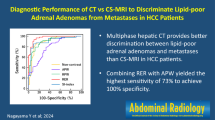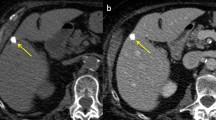Abstract
Purpose
The aim of this study was to investigate the feasibility of quantitative image analysis to differentiate hepatic nodules on gray-scale sonographic images.
Methods
We retrospectively evaluated 35 nodules from 31 patients with hepatocellular carcinoma (HCC), 60 nodules from 58 patients with liver hemangioma, and 22 nodules from 22 patients with liver metastasis. Gray-scale sonographic images were evaluated with subjective judgment and image analysis using ImageJ software. Reviewers classified the shape of nodules as irregular or round, and the surface of nodules as rough or smooth.
Results
Circularity values were lower in the irregular group than in the round group (median 0.823, 0.892; range 0.641–0.915, 0.784–0.932, respectively; P = 3.21 × 10−10). Solidity values were lower in the rough group than in the smooth group (median 0.957, 0.968; range 0.894–0.986, 0.933–0.988, respectively; P = 1.53 × 10−4). The HCC group had higher circularity and solidity values than the hemangioma group. The HCC and liver metastasis groups had lower median, mean, modal, and minimum gray values than the hemangioma group. Multivariate analysis showed circularity [standardized odds ratio (OR), 2.077; 95 % confidential interval (CI) = 1.295–3.331; P = 0.002] and minimum gray value (OR 0.482; 95 % CI = 0.956–0.990; P = 0.001) as factors predictive of malignancy. The combination of subjective judgment and image analysis provided 58.3 % sensitivity and 89.5 % specificity with AUC = 0.739, representing an improvement over subjective judgment alone (68.4 % sensitivity, 75.0 % specificity, AUC = 0.701) (P = 0.008).
Conclusion
Quantitative image analysis for ultrasonic images of hepatic nodules may correlate with subjective judgment in predicting malignancy.





Similar content being viewed by others
References
Mailloux GE, Bertrand M, Stampfler R, et al. Texture analysis of ultrasound B-mode images by segmentation. Ultrason Imaging. 1984;6:262–77.
Layer G, Zuna I, Loren A, et al. Computerized ultrasound B-scan texture analysis of experimental diffuse parenchymal liver disease: correlation with histopathology and tissue composition. J Clin Ultrasound. 1991;19:193–201.
Sujana H, Swarnamani S, Suresh S. Application of artificial neural networks for the classification of liver lesions by image texture parameters. Ultrasound Med Biol. 1996;22:1177–81.
Badawi AM, Derbala AS, Youssef AM. Fuzzy logic algorithm for quantitative tissue characterization of diffuse liver diseases from ultrasound images. Int J Med Inform. 1999;55:135–47.
Wang Y, Itou K, Taniguchi N, et al. Studies on tissue characterization by texture analysis with cooccurrence matrix method using ultrasonography and CT imaging. J Med Ultrason. 2002;29:211–23.
Yamada H, Ebara M, Yamaguchi T, et al. A pilot approach for quantitative assessment of liver fibrosis using ultrasound: preliminary results in 79 cases. J Hepatol. 2006;44:68–75.
Jung EM, Clevert DA, Schreyer AG, et al. Evaluation of quantitative contrast harmonic imaging to assess malignancy of liver tumors: a prospective controlled two-center study. World J Gastroenterol. 2007;13:6356–64.
Wakui N, Takayama R, Kanekawa T, et al. Usefulness of arrival time parametric imaging in evaluating the degree of liver disease progression in chronic hepatitis C infection. J Ultrasound Med. 2012;31:373–82.
Yoshida H, Casalino DD, Keserci B, et al. Wavelet-packet-based texture analysis for differentiation between benign and malignant liver tumours in ultrasound images. Phys Med Biol. 2003;48:3735–53.
Mitrea D, Mitrea P, Nedevschi S, et al. Abdominal tumor characterization and recognition using superior-order cooccurrence matrices, based on ultrasound images. Comput Math Methods Med. 2012;2012:348135.
Virmani J, Kumar V, Kalra N, et al. Characterization of primary and secondary malignant liver lesions from B-mode ultrasound. J Digit Imaging. 2013;26:1058–70.
ImageJ User guide. V Menu commands 30 Analyze. Available from http://imagej.nih.gov/ij/docs/guide/146-30.html#toc-Subsection-30.2.
Makuuchi M, Hasegawa H, Yamazaki S, et al. Ultrasonic characteristics of the small hepatocellular carcinoma. Ultrasound Med Biol. 1983;489–91.
Mirk P, Rubaltelli L, Bazzocchi M, et al. Ultrasonographic patterns in hepatic hemangiomas. J Clin Ultrasound. 1982;8:373–8.
Ito H, Tsujimoto F, Nakajima Y, et al. Sonographic characterization of 271 hepatic hemangiomas with typical appearance on CT imaging. J Med Ultrasonics. 2012;39:61–8.
Yoshida T, Matsue H, Okazaki N, et al. Ultrasonographic differentiation of hepatocellular carcinoma from metastatic liver cancer. J Clin Ultrasound. 1987;15:431–7.
Le Y, Xianze Xu, Li Zha, et al. Tumor boundary detection in ultrasound imagery using multi-scale generalized gradient vector flow. J Med Ultrasound. 2015;42:25–38.
Kanai T, Hirohashi S, Upton MP, et al. Pathology of small hepatocellular carcinoma. A proposal for a new gross classification. Cancer. 1987;60:810–9.
Tsujimoto F, Abe T, Murakami Y, et al. Temporal changes of internal echoes in hepatic hemangiomas. J Jpn Radiol Soc. 1989;49:574–82.
Conflict of interest
The authors declare that there is no conflict of interest. Naoki Matsumoto has no conflict of interest. Masahiro Ogawa has no conflict of interest. Kentaro Takayasu has no conflict of interest. Midori Hirayama has no conflict of interest. Takao Miura has no conflict of interest. Katsuhiko Shiozawa has no conflict of interest. Masahisa Abe has no conflict of interest. Hiroshi Nakagawara has no conflict of interest. Mitsuhiko Moriyama has no conflict of interest. Seiichi Udagawa has no conflict of interest.
Ethical standard
All procedures followed were in accordance with the ethical standards of the responsible committee on human experimentation (institutional and national) and with the Helsinki Declaration of 1975, as revised in 2008. Informed consent was obtained from all patients for being included in the study.
Author information
Authors and Affiliations
Corresponding author
About this article
Cite this article
Matsumoto, N., Ogawa, M., Takayasu, K. et al. Quantitative sonographic image analysis for hepatic nodules: a pilot study. J Med Ultrasonics 42, 505–512 (2015). https://doi.org/10.1007/s10396-015-0627-3
Received:
Accepted:
Published:
Issue Date:
DOI: https://doi.org/10.1007/s10396-015-0627-3




